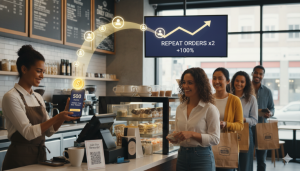A retail marketing strategy is a detailed plan for creating and promoting products to attract and retain customers while increasing sales.
Using the correct marketing methods may help your retail business grow by increasing brand awareness and building confidence in the products sold in your online and brick-and-mortar locations.
Whether you’re a seasoned business owner or just starting, it’s critical to analyze and establish a retail marketing plan regularly.
This guide will teach you all you need to know about retail marketing and the strategies that will help you flourish in 2022 and beyond.
What is Retail Marketing?
Retail marketing promotes a retailer’s goods and services to a specific demographic to raise awareness, establish goodwill, and increase sales.
A retailer can sell its services in a variety of ways. Some are free, while others cost a fee.
It’s vital to realize that e-commerce and traditional businesses utilize retail marketing. Almost every merchant, in some way or another, uses retail marketing. It is also clear that internet channels are rising in popularity. The majority of shoppers conduct their retail product research through search engines.
4 Principles of Retail Marketing
You may use four essential elements to break down the core approach to retail marketing. Product, pricing, location, and promotion are the four gold standards of retail marketing.
Product
Even though retailers rarely produce their own goods, their product variety remains a crucial selling factor. Customers want to know that you have precisely what they desire.
Hard or durable goods such as appliances, electronics, and athletic equipment and soft goods like clothing, home items, cosmetics, and paper products are the types of goods available.
Some establishments may sell a mix of various items, such as supermarkets. Other retailers may specialize in a single kind, for example, boutique clothing stores.
It’s critical to organize anything you’re selling into a neat unit. You can accomplish this approach by adopting appropriate packaging and ensuring that your products are classified correctly, including using standard systems like the hcpcs level 1 codes for healthcare products if applicable
According to Inc., Of the 95 percent of items failing to stay on store shelves each year, Inc. believes product packaging is the primary reason.
It is essential to put in the time and effort to ensure that your product’s packaging considers the demographic you cater to. You also want to try and be unique and personalize your product’s packaging while keeping in mind the money it takes to do so.
Pricing
The second principle of your marketing strategy is the pricing of your product.
Overhead expenditures, competition, profit, demand, product positioning, and market circumstances are just a few of the elements to consider. You must locate the sweet spot for your product’s pricing to maximize sales.
The four most prevalent pricing techniques are competitive pricing, everyday low pricing, high/low pricing, and pricing ending.
- Competitive Pricing:
Retailers can set pricing based on what their competitors are charging. Once higher pricing strategies like the high/low pricing are exhausted, retailers utilize this method.
- Everyday Low Pricing:
The retailer runs on razor-thin profit margins and attracts customers looking for the best deal.
- High/Low Pricing:
The retailer initially sets a high price and then lowers it when the item’s demand decreases.
- Pricing Ending:
The retailer sets the pricing of things with odd numbers, giving the impression that they are cheaper. Consider pricing things at $9.95 instead of $10 to give the impression that the item is less expensive in the eyes of the buyer.
Place
You could have the best product, packaging, and price in the world, but if it’s out of reach for your customers, you’re in trouble! As a result, make sure you pick the ideal placement for your goods.
You may refer to the area or platform where you offer your items as “place.”
You may place your product in front of your customer through distribution channels. It would help to evaluate where your target customer shops when determining which channel to use.
Promotion
Knowing how to properly engage with your customers and pique their interest in your product is the essence of promotion.
Retail marketing aims to engage with customers and increase their awareness of your business.
Customers will not think of you when they need a product if they are unaware that you exist.
Even after they’ve reached the initial level of awareness, they might need to interact with your business a few more times before they feel confident enough to make their first purchase.
Customer-Based Retail Marketing
Consumer-centricity entails putting the customer first by gaining a deeper understanding of their requirements and purchasing habits.
Lauterborn altered the 4 Ps of Retail Marketing and replaced them with the 4 Cs: Consumer wants and needs, Cost to satisfy, Convenience to buy, and Communication.
The change in marketing for retail is an adaption to meet the need for a more customer-oriented approach to marketing.
Consumer Wants and Needs
A savvy retailer researches the desires and requirements of its customers before coming to market, rather than focusing on the goods the retailer wants to offer.
The more a retailer understands its consumer base’s demands and requirements, the more likely it will attract new customers and increase sales.
Cost to Satisfy
A cost in retail is the amount of money you spend to create something. Various factors influence cost, including switching to a new product and the cost of not choosing a competitor’s product.
Convenience to Buy
Due to the Internet, ‘Place’ has become less critical in customer purchase decisions.
Convenience refers to the ease with which customers may complete a transaction, including finding accessible information on a product, they can find the right product, and they can purchase the product.
Communication
Advertising, public relations, social media, and any other communication between the corporation and the customer are all examples of communications.
Importance of Retail Marketing
Given how competitive some product categories are, marketing is vital in retail.
You cannot pin your sales and profits on the hope that customers will remember you if they get interested in a product you provide.
Unlike subscriptions or one-time purchases, customers buy retail items frequently, so businesses must rely on marketing efforts to win back customers after each sale.
Marketing is more important in retail than in any other business for increasing a customer’s lifetime value.
Retail Marketing Strategies
Here are some ideas for captivating retail marketing strategies that you can employ to attract potential and existing customers to purchase from you and increase your customer’s lifetime value.
Focus on Your Storefront
Looking at the outside of your business and critically considering the message you’re giving is the first step in developing a marketing plan for your retail business.
The storefront is the initial impression of your business for potential consumers and passers-by. As a result, you should treat the outside of your shop with the same respect as the inside.
Retailers should think about the tactics they’re employing to entice people inside. Customers can tell you have high-quality, intriguing items with a well-designed storefront.
Even the most minor details can have a significant impact. A fresh coat of paint or power cleaning your walkway and brickwork does your storefront wonders.
Window displays are a vital aspect of any retail strategy, especially for shops located on a busy street.
Choose a theme that appeals to customers when building a window display. To make your exhibit aesthetically engaging, use complementary colors and a variety of heights and depths.
Outdoor signage is another crucial part of any marketing strategy.
According to one study, 80 percent of customers would prefer to shop at a new business with a welcoming exterior versus one without.
Invest in the Right Digital Sales Channels
Having an online presence is necessary to appeal to today’s customers.
Around 88 percent of adults in the United States shop online. If you don’t have an online store, you’re missing out on many sales from people in your neighborhood and across the country.
Your website or mobile application is your digital storefront, just as your physical storefront is the first impression of your company.
To keep people coming back to your company, you need to take the time to build a digital customer experience that is both memorable and pleasurable. So, partnering with a digital marketing agency can help businesses establish a robust online presence through on-page and off-page strategies. These strategies include optimizing website content, utilizing the benefits of SEO link-building services, leveraging social media marketing, and so on.
Fortunately, setting up an online business is simple with the correct tools.
Blink is a quick commerce enablement platform that allows users to provide customers with online ordering platforms with branded websites and mobile apps for Android and iOS.
With Blink’s knowledge and resources, your company can enter the world of eCommerce and quick commerce without the hassle of building platforms from scratch.
Delve Into SMS Marketing
SMS marketing has gotten a lot of attention, and for a good reason: consumers are addicted to their phones.
According to research, Americans check their phones 52 times each day. Text message open rates may exceed 98 percent, making it a very successful marketing channel for retailers to reach potential and existing consumers.
You may increase customer engagement by reaching out to them in a timely and convenient manner where they already spend a lot of their time.
More engaged customers are more likely to buy. As a result, it’s worthwhile to experiment with SMS marketing for your retail business.
That is why, if you haven’t yet dabbled in SMS marketing, now is the moment. Begin gathering your clients’ mobile phone numbers and sending them appropriate marketing communications with their permission.
Furthermore, text message campaigns are simpler to design, organize, test and iterate depending on previous campaign outcomes.
With Blink’s in-built SMS Marketing tools, you can efficiently run your text message marketing campaign for your retail business and see how your online sales are doing with the business analytics tools.
To learn more about Blink’s online ordering system, book a demo with one of our representatives today.
Social Media Marketing
Whether retail or not, almost every business has a social media presence. You may spend money on social media advertising to get in front of individuals who are likely to buy your items and convert or send them down your sales funnel.
Since social media has become so important in many people’s lives, you may begin targeting customers who are directly interested in the items and services you offer in your retail business, whether online or offline.
Instagram and Facebook are excellent for keeping in touch with existing consumers. Instagram, in particular, is particularly beneficial since Instagram Stories allows you to communicate directly with customers. Many shops now utilize Stories to show off new items and provide behind-the-scenes footage to their customers.
Facebook is an excellent platform for promoting your store’s events and new products. Facebook Advertising may be a highly successful aspect of your retail strategy to attract new local customers.
You may use all of these social media outlets to fine-tune your messaging, test pricing, and highlight your most important items. Analyze the outcomes of your social ads to identify which messaging, and price combinations are most effective.
Video Marketing
In many circumstances, seeing your products in action is the most effective method to promote them.
Seeing the product as such is simple to do in-store, where customers can touch, feel, and even try things. When promoting online, though, you must be more inventive with your approach.
Enter video marketing. When used effectively, video is a terrific tool for displaying your product’s use cases and value proposition.
When people watch your videos, you want them to feel connected to your business. Make the information as relatable as possible to achieve this. Begin by showcasing people who resemble your target market.
You should also figure out which platform is suitable for your videos. The platform on which your videos will reside determines factors such as the length of your videos, the content you’ll generate, and the themes and effects you’ll add to the content.
Retail Marketing Today
Every year, retail marketing evolves, yet many of the same methods have proven successful for decades.
Suppose you want to stand out in a competitive online marketplace. In that case, you’ll need to figure out how to leverage your product, pricing, location, and promotional value while conveying it to your potential customers.
Blink offers the solutions that can help in this process, allowing you to connect and communicate with your customers and provide an online presence that will set your brand apart from the competition.
With added tools such as order management, customer data ownership, data analytics, marketing tools, and much more, creating a retail marketing strategy can be easy, and your online presence can stand out.
[INSERT_ELEMENTOR id=”10819″]
Related Articles:
 The Ultimate Guide on Starting your Own Food Truck Business
The Ultimate Guide on Starting your Own Food Truck Business
 How to Calculate Food Cost Percentage (with REAL examples)
How to Calculate Food Cost Percentage (with REAL examples)
 20+ Restaurant Industry Statistics Restaurant Owners Need to Know
20+ Restaurant Industry Statistics Restaurant Owners Need to Know
 How to Increase Restaurant Sales: 4 Ultimate Strategies to Win More Customers
How to Increase Restaurant Sales: 4 Ultimate Strategies to Win More Customers
 What Are The Requirements To Open a Restaurant in Saudi Arabia?
What Are The Requirements To Open a Restaurant in Saudi Arabia?






